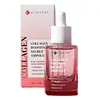What's inside
What's inside
 Key Ingredients
Key Ingredients

 Benefits
Benefits

 Concerns
Concerns

 Ingredients Side-by-side
Ingredients Side-by-side

Water
Skin ConditioningGlycerin
HumectantHydrogenated Poly(C6-14 Olefin)
EmollientPropanediol
SolventPentaerythrityl Tetraethylhexanoate
EmollientNiacinamide
SmoothingDimethicone
EmollientButylene Glycol
HumectantButyrospermum Parkii Butter
Skin ConditioningHydrogenated Vegetable Oil
EmollientHydroxypropyltrimonium Hyaluronate
Hydrolyzed Hyaluronic Acid
HumectantPalmitoyl Tripeptide-5
Skin ConditioningAcetyl Hexapeptide-8
HumectantLavandula Angustifolia Oil
MaskingCitrus Aurantium Dulcis Peel Oil
MaskingRosmarinus Officinalis Leaf Oil
MaskingCedrus Atlantica Bark Oil
MaskingAdenosine
Skin ConditioningGlyceryl Stearate Citrate
EmollientPolyglyceryl-3 Methylglucose Distearate
EmulsifyingGlyceryl Stearate
EmollientCetearyl Alcohol
EmollientPalmitic Acid
EmollientStearic Acid
CleansingDimethicone/Vinyl Dimethicone Crosspolymer
Skin ConditioningGlyceryl Caprylate
EmollientSodium Polyacrylate
AbsorbentXanthan Gum
EmulsifyingCaprylyl Glycol
Emollient1,2-Hexanediol
Skin ConditioningEthylhexylglycerin
Skin ConditioningDisodium EDTA
Carbomer
Emulsion StabilisingTromethamine
BufferingLinalool
PerfumingLimonene
PerfumingWater, Glycerin, Hydrogenated Poly(C6-14 Olefin), Propanediol, Pentaerythrityl Tetraethylhexanoate, Niacinamide, Dimethicone, Butylene Glycol, Butyrospermum Parkii Butter, Hydrogenated Vegetable Oil, Hydroxypropyltrimonium Hyaluronate, Hydrolyzed Hyaluronic Acid, Palmitoyl Tripeptide-5, Acetyl Hexapeptide-8, Lavandula Angustifolia Oil, Citrus Aurantium Dulcis Peel Oil, Rosmarinus Officinalis Leaf Oil, Cedrus Atlantica Bark Oil, Adenosine, Glyceryl Stearate Citrate, Polyglyceryl-3 Methylglucose Distearate, Glyceryl Stearate, Cetearyl Alcohol, Palmitic Acid, Stearic Acid, Dimethicone/Vinyl Dimethicone Crosspolymer, Glyceryl Caprylate, Sodium Polyacrylate, Xanthan Gum, Caprylyl Glycol, 1,2-Hexanediol, Ethylhexylglycerin, Disodium EDTA, Carbomer, Tromethamine, Linalool, Limonene
Water
Skin ConditioningCollagen Extract
Skin ConditioningMethylpropanediol
SolventBifida Ferment Filtrate
Skin ConditioningGlycerin
Humectant1,2-Hexanediol
Skin ConditioningAlcohol
AntimicrobialButylene Glycol
HumectantCarbomer
Emulsion StabilisingPPG-13-Decyltetradeceth-24
EmulsifyingTromethamine
BufferingHyaluronic Acid
HumectantAdenosine
Skin ConditioningParfum
MaskingDisodium EDTA
Panthenol
Skin ConditioningLactobacillus Ferment
Skin ConditioningEthylhexylglycerin
Skin ConditioningCollagen
MoisturisingHydrogenated Lecithin
EmulsifyingHydroxydecyl Ubiquinone
AntioxidantLactococcus Ferment Extract
Skin ConditioningBifida Ferment Extract
HumectantLactobacillus Ferment Lysate
Skin ConditioningArgania Spinosa Kernel Oil
EmollientYeast Extract
Skin ConditioningTocopherol
AntioxidantWater, Collagen Extract, Methylpropanediol, Bifida Ferment Filtrate, Glycerin, 1,2-Hexanediol, Alcohol, Butylene Glycol, Carbomer, PPG-13-Decyltetradeceth-24, Tromethamine, Hyaluronic Acid, Adenosine, Parfum, Disodium EDTA, Panthenol, Lactobacillus Ferment, Ethylhexylglycerin, Collagen, Hydrogenated Lecithin, Hydroxydecyl Ubiquinone, Lactococcus Ferment Extract, Bifida Ferment Extract, Lactobacillus Ferment Lysate, Argania Spinosa Kernel Oil, Yeast Extract, Tocopherol
Ingredients Explained
These ingredients are found in both products.
Ingredients higher up in an ingredient list are typically present in a larger amount.
1,2-Hexanediol is a synthetic liquid and another multi-functional powerhouse.
It is a:
- Humectant, drawing moisture into the skin
- Emollient, helping to soften skin
- Solvent, dispersing and stabilizing formulas
- Preservative booster, enhancing the antimicrobial activity of other preservatives
Adenosine is in every living organism. It is one of four components in nucleic acids that helps store our DNA.
Adenosine has many benefits when used. These benefits include hydrating the skin, smoothing skin, and reducing wrinkles. Once applied, adenosine increases collagen production. It also helps with improving firmness and tissue repair.
Studies have found adenosine may also help with wound healing.
In skincare products, Adenosine is usually derived from yeast.
Learn more about AdenosineButylene Glycol (or BG) is used within cosmetic products for a few different reasons:
Overall, Butylene Glycol is a safe and well-rounded ingredient that works well with other ingredients.
Though this ingredient works well with most skin types, some people with sensitive skin may experience a reaction such as allergic rashes, closed comedones, or itchiness.
Learn more about Butylene GlycolCarbomer is a polymer of acrylic acid. Its main role is to create a gel consistency.
A high amount of carbomer can cause pilling or balling up of products. Don't worry, most products contain 1% or less of carbomer.
Disodium EDTA plays a role in making products more stable by aiding other preservatives.
It is a chelating agent, meaning it neutralizes metal ions that may be found in a product.
Disodium EDTA is a salt of edetic acid and is found to be safe in cosmetic ingredients.
Learn more about Disodium EDTAEthylhexylglycerin (we can't pronounce this either) is commonly used as a preservative and skin softener. It is derived from glyceryl.
You might see Ethylhexylglycerin often paired with other preservatives such as phenoxyethanol. Ethylhexylglycerin has been found to increase the effectiveness of these other preservatives.
Glycerin is already naturally found in your skin. It helps moisturize and protect your skin.
A study from 2016 found glycerin to be more effective as a humectant than AHAs and hyaluronic acid.
As a humectant, it helps the skin stay hydrated by pulling moisture to your skin. The low molecular weight of glycerin allows it to pull moisture into the deeper layers of your skin.
Hydrated skin improves your skin barrier; Your skin barrier helps protect against irritants and bacteria.
Glycerin has also been found to have antimicrobial and antiviral properties. Due to these properties, glycerin is often used in wound and burn treatments.
In cosmetics, glycerin is usually derived from plants such as soybean or palm. However, it can also be sourced from animals, such as tallow or animal fat.
This ingredient is organic, colorless, odorless, and non-toxic.
Glycerin is the name for this ingredient in American English. British English uses Glycerol/Glycerine.
Learn more about GlycerinTromethamine helps balance the pH and improve the texture of a product. It is synthetically created.
As an emulsifier, Tromethamine prevents oil and water ingredients from separating. This helps stabilize the product and elongate a product's shelf life. Tromethamine also makes a product thicker.
Tromethamine helps balance the pH level of a product. Normal pH level of skin is slightly acidic (~4.75-5.5). The acidity of our skin is maintained by our glands and skin biome. Being slightly acidic allows our skin to create an "acid mantle". This acid mantle is a thin barrier that protects our skin from bacteria and contaminants.
Oral Tromethanmine is an anti-inflammatory drug but plays the role of masking, adding fragrance, and/or balancing pH in skincare.
1,3-Propanediol, 2-amino-2-(hydroxymethyl)-
Learn more about TromethamineWater. It's the most common cosmetic ingredient of all. You'll usually see it at the top of ingredient lists, meaning that it makes up the largest part of the product.
So why is it so popular? Water most often acts as a solvent - this means that it helps dissolve other ingredients into the formulation.
You'll also recognize water as that liquid we all need to stay alive. If you see this, drink a glass of water. Stay hydrated!
Learn more about Water